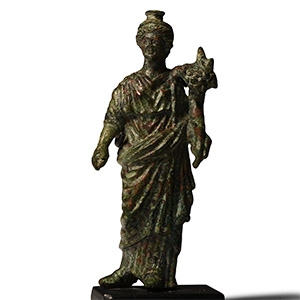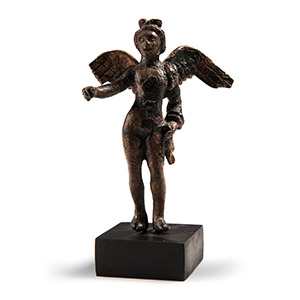Home > Auctions > 4 June - 8 June 2024
Ancient Art, Antiquities, Natural History & Coins
Auction Highlights:
Old private British collection, pre-1965.
Property of a gentleman; acquired in the UK before 2000.
Accompanied by a copy of an old black and white photograph and an academic report by Dr Raffaele D’Amato.
This lot has been checked against the Interpol Database of stolen works of art and is accompanied by a search certificate number no.12033-215424.
Cf. Bailey, D.M., A catalogue of the lamps in the British Museum, IV, Lamps of metal and stone, and lampstands, London, 1996, no. Q3669 (said to be from Rome) for identical, and Q3670 (preserved only in the identical mask); many other similar examples are from Pompeii, see Valenza Mele, N., Museo Nazionale Archeologico di Napoli, Catalogo delle Lucerne di Bronzo, Rome, 1981, nos.344-345; from the Western Provinces, see Rolland, H., Bronze Antiques de Haute Provence, Paris, 1965, no.357; and from the East, see Bérard, C., Bronzes Hellénistiques et Romains, Lausanne, 1979, pl.116, 7 and 10; cf. also Mitten, D.G., Doeringer, S.F., Master Bronzes from the Classical World, Cambridge, 1967, no.297, for identical, and Edgar, C.C., Greek Bronzes, Catalogue général des antiquités égyptiennes du Musee du Caire, Cairo, 1904, pl.12H.
The lamp is of Loeschke type XX (Walters type 6), with many of these lamps made in Italy, but some are also found in the East. The tragic mask appears frequently on lamp handles, probably as an apotropaic subject. The mask was an inseparable element of unity with the past and religious context.
Acquired on the German art market, 1989-1995.
with The Museum Gallery, 19 Bury Place, London, WC1, UK, 1998-2003.
Property of a London based academic, 2003-present.
This lot has been checked against the Interpol Database of stolen works of art and is accompanied by a search certificate number no.12097-214786.
This fragment of a sarcophagus front is probably a remnant of a Jewish sarcophagus from the Roman period. It belongs to a style of sarcophagi made in the Levant, often decorated with dolphins, sphinxes and other symbols of the hereafter.
Acquired from Cadogan Tate, Paris, 2011.
From the Keane private collection, Kent, UK.
Accompanied by a copy of the official shipping document (4,000 euros).
Accompanied by an original French certificate of export issued by the French Ministry of Culture, no.129472.
Acquired 1970s-early 1990s.
Property of a North American collector.
London collection, 2016.
See Payne, G., Roman Leaden Coffin discovered at Plumstead in Archaeologia Cantiana, Vol.17, 1887, fig.10, for the presence of lead sarcophagi in Roman Britain; for a similar specimen in the Metropolitan Museum of Art, accession no.31.116a-i; Penn Museum, coffin panel B10280, from Lebanon (Tyre).
From an Egyptian family collection, Alexandria and Cairo, acquired in the early part of the 20th century in Egypt and Europe, and transferred from Egypt to northern European family residences in the early 1950s.
Northern European private collection, by direct descent from the above in the 1970s.
Acquired from the above by the previous owner in 2002.
with Sotheby’s, New York, 5 June 2013, no.88.
German private collection.
Accompanied by copies of the German cultural export licence and copies of the relevant Sotheby’s catalogue pages.
Accompanied by an academic report by Dr Raffaele D’Amato.
This lot has been checked against the Interpol Database of stolen works of art and is accompanied by a search certificate number no.12042-216438.
Cf. Daremberg & Saglio, Dictionnaire des Antiquités Grecques et Romaines, Paris, 1873-1917, sub voce Flora, p.1189; see for a Roman prototype the Flora Capitolina, Museo Capitolino, Stanza del Gladiatore, no.14, inv. no.743 in Negrete Plano, A. (ed.), Anton Raphael Mengs y la Antigüedad, Real Academia de Bellas Artes de San Fernando; Fundación Mapfre, Madrid, 2013, pp. 170-171.
Statuettes like the present one were used in the service of domestic cults and reflected native Greek or Roman cult practices. The Roman household shrine, or lararium, receives its name from the lares, the guardian spirits of the house and household, who were frequently displayed in the shrine, either in painted or sculpted form.
From a collection acquired on the UK art market from various auction houses and collections mostly before 2000.
From an important Cambridgeshire estate; thence by descent.
Cf. Durham, E., Metal Figurines in Roman Britain, vol. 2, Reading, 2010, pl.60, for a full-length figure from Lakenheath, England, with similar features; cf. also De Ridder, A., Les bronzes antiques du Louvre, 1, Les figurines, Paris, 1913, p.129, pl.62, no.1059, for identical.
Exhibited at Harwich Museum, Harwich, Essex, UK, 14th March-9th June 2024; accompanied by a copy of a photograph of the artefact on display.
The cult of Helios-Apollo intensified in the third century A.D. and the adoration of Sol Invictus, with the radiate crown, was often linked to that of Mithras, the god of legions, whose symbol was the bull. Under Emperor Aurelian, the Sol Invictus became the main god, protector of Rome and the Roman state.
From a collection acquired on the UK art market from various auction houses and collections mostly before 2000.
From an important Cambridgeshire estate; thence by descent.
Cf. Reinach, S., Repertoire de la statuarie Grecque et Romaine, Paris, 1930, pp.276ff., for the type; Rolland, H., Bronzes Antiques de Haute Provence, Paris, 1965, item 67, for similar.
Exhibited at Harwich Museum, Harwich, Essex, UK, 14th March-9th June 2024; accompanied by a copy of a photograph of the artefact on display.
The figure is a hybrid based on representation of Roman Minerva, closely associated with Greek Athena. The missing attributes are the spear and the shield, according to the type of Minerva of Firenze (Reinach, 1930, p.278).
From a collection acquired on the UK art market from various auction houses and collections mostly before 2000.
From an important Cambridgeshire estate; thence by descent.
Cf. Boucher, S., Tassinari, S., Bronze Antiques du Musée de la civilisation Gallo-Romaine a Lyon, 1. Inscriptions, Statuaire, Vaisselle, Lyon, 1976, nos.20-21,38 (Fortuna and Isis-Fortuna); also Descamps-Lequime, S, 'Acquisitions' in La Revue des musées de France. Revue du Louvre, 2, 2016, p.91, fig. 109, no.109, Louvre inventory Br 6045.
Statuettes of Fortuna, the goddess of chance, were evidently popular during the Roman Imperial times judging by the large number that have been found, and with the advent of the cult of Isis within the Roman Empire, the two divinities were identified as a single goddess.
From a collection acquired on the UK art market from various auction houses and collections mostly before 2000.
From an important Cambridgeshire estate; thence by descent.
See Swan Hall, E., 'Harpocrates and Other Child Deities in Ancient Egyptian Sculpture' in Journal of the American Research Center in Egypt, Vol. 14, 1977, pp.55-58, fig.1, pl.XXVII; fig.4, pl.XXVIII, for similar types.
The cult of Harpocrates, began in Ptolemaic times, expanding considerably in the Imperial Roman period, and absorbing influences from the cult of ram of Mendes, the ithyphallic Min, the crocodile god Sobek, and Hercules. The missing left hand probably held a small cornucopia.
From an old French collection.
Acquired from Gallery Drees Archéo, 2008.
Ex Gilles Grimm collection.
Property of a French collector.
Accompanied by a copy of the 2008 invoice.
Cf. Boucher, S., Tassinari, S., Bronze Antiques du Musée de la civilisation Gallo-Romaine a Lyon, 1. Inscriptions, Statuaire, Vaisselle, Lyon, 1976, nos.20-21, 38 (Fortuna and Isis-Fortuna).
From a collection acquired on the UK art market from various auction houses and collections mostly before 2000.
From an important Cambridgeshire estate; thence by descent.
Cf. Rolland, H., Bronzes Antiques de Haute Provence, Paris, 1965, items 27ff., for type.
Mercury is one of the most widespread divinities among the votive statuettes of Roman Age. The god of the Roman pantheon was similar to the Greek Hermes and the Etruscan Turms.
From a collection acquired on the UK art market from various auction houses and collections mostly before 2000.
From an important Cambridgeshire estate; thence by descent.
See Reinach, S., Répertoire de la statuaire Grecque et Romaine, Paris, 1897, p.396, for similar iconography of the goddess.
Eos, the ancient Greek goddess of the dawn, was perhaps the most resplendent of all the beings in the Greek pantheon. With the brilliant dye of saffron as her colour, she was also associated with roses, which also embody the glowing hues of the dawn.
73 - 84 of 2809 LOTS

.jpg)

.jpg)
.jpg)
.jpg)
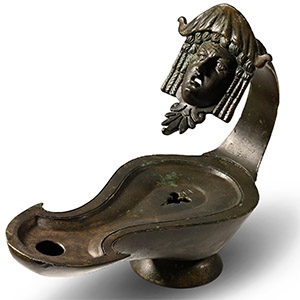
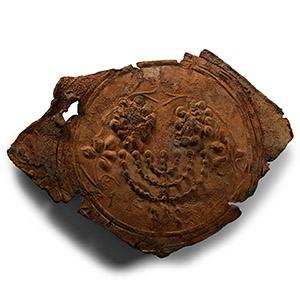
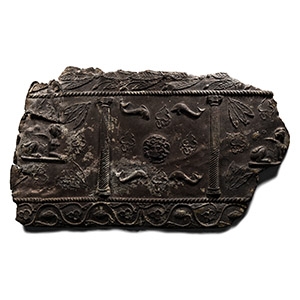
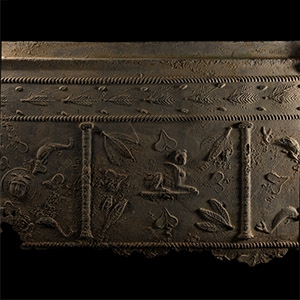
.jpg)
.jpg)
.jpg)
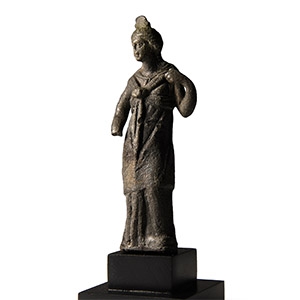
.jpg)
